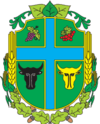Novoselytsia Raion
Novoselytsia Raion (Ukrainian: Новоселицький район, Romanian: Raionul Noua Suliță pronounced [raˈjonul ˈnowa ˈsulit͡sə]) is a raion (administrative district) in Chernivtsi Oblast, (province) in the west of Ukraine. The western part of its territory lies in the historical region of Bukovina, the eastern part in Bessarabia, while one village (Boianivka) is part of the Hertza region. The center of the raion is the town of Novoselytsia. Population: 78,075 (2015 est.)[1]
Novoselytsia Raion Новоселицький район (in Ukrainian) Raionul Noua Suliță (in Romanian) | |
|---|---|
 Flag  Coat of arms | |
 | |
| Coordinates: 48°17′36″N 26°19′15″E | |
| Country | |
| Region | Chernivtsi Oblast |
| Established | 1940 |
| Admin. center | Novoselytsia |
| Subdivisions | List
|
| Government | |
| • Governor | N/A |
| Area | |
| • Total | 734 km2 (283 sq mi) |
| Population | |
| • Total | 78,075 |
| • Density | 110/km2 (280/sq mi) |
| Time zone | UTC+02:00 (EET) |
| • Summer (DST) | UTC+03:00 (EEST) |
| Postal index | 604XX |
| Area code | 380-3733X |
| Website | [?] |
History and population
From 1775 to 1918, Bukovina was an administrative division of the Habsburg Monarchy, and a province of Austria–Hungary (Austrian half).[2] After World War I, Bucovina became part of Romania. In 1940, the northern half of Bucovina was annexed by the Soviet Union.
.jpg)
According to the 2001 Ukrainian Census, the raion's population was 87,241. The ethnical composition was as follows:
| Total | Ukrainians | Russians | Romanians | Moldovans | Other | |
|---|---|---|---|---|---|---|
| 87,461 | 29,703 | 1,235 | 5,904 | 50,329 | 290 | |
Sofia Rotaru was born in Marshintsy, one of the Romanian speaking villages of Novoselytskyi Raion.
The village of Tarasivtsi, located in the raion, is notable as the only place in Ukraine where the Moldovan (Romanian) language has been designated as a regional language. This occurred after Ukraine permitted regional languages to be designated in August 2012 .[3]
Administrative divisions
Novoselytsia Raion has 1 town and 30 communes:
- Novoselytsia - administrative seat
Of these, Boiany, Chornivka, Mahala, Sloboda, Pripruttia, Toporivtsi and Zelenyi Hai are in the historical region of Bukovina, while the remainder are in Bessarabia.
References
- "Чисельність наявного населення України (Actual population of Ukraine)" (PDF) (in Ukrainian). State Statistics Service of Ukraine. Retrieved 1 July 2016.
- Die postalischen Abstempelungen auf den österreichischen Postwertzeichen-Ausgaben 1867, 1883 und 1890, Wilhelm KLEIN, 1967
- "Popov: No bilingualism in Kyiv", Kyiv Post, September 19, 2012
External links
- Novoselytskyi Raion - official website (in Ukrainian)
- Verkhovna Rada website - Administrative divisions of Novoselytskyi Raion (in Ukrainian)